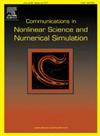磁悬浮隔振系统隔振效果的研究
IF 3.8
2区 数学
Q1 MATHEMATICS, APPLIED
Communications in Nonlinear Science and Numerical Simulation
Pub Date : 2025-06-18
DOI:10.1016/j.cnsns.2025.109089
引用次数: 0
摘要
该文件提出了一种无摩擦,刚度可修改的隔振器,利用电磁力获得负刚度,解决了系统稳定性和隔振能力之间的矛盾。首先利用磁悬浮隔振器(MSVI)的理论公式建立隔振系统的控制方程,然后求解隔振系统的动态响应,进行稳定性分析和数值验证。随后,分析了各种关键因素对隔振性能的影响。根据研究结果,设计了MSVI的静态实验,并将实验结果拟合到电磁力静态模型中。最后,将MSVI安装在单层隔振试验台上,在0-15Hz扫描频率条件下对包含MSVI的隔振系统的性能进行了验证,并对实验结果进行了讨论和检验。研究结果表明,在提高系统隔振能力的同时,增大了系统的振动强度,降低了系统的稳定性。随着激励幅值的增大,频率响应曲线趋于左弯曲,系统处于不稳定区间。在扫频试验中,MSVI系统上电时隔离启动频率提高1.91Hz至10.83Hz,峰值透射率下降43.07%至10.89dB。上述结果清楚地显示了MSVI在大电流下降低隔离启动频率和峰值透射率以避免不稳定的优势。本研究旨在解决系统稳定性与隔振能力不一致的问题,对非线性隔振控制具有一定的理论研究和工程应用价值。本文章由计算机程序翻译,如有差异,请以英文原文为准。
Design and experimental study of quasi-zero stiffness vibration isolator based on electromagnetic attraction type
This paper proposes a frictionless stiffness-adjustable magnetic suspension vibration isolator (MSVI). By utilizing the displacement of an l-shaped armature connected to the bearing platform to adjust air gap dimensions between upper and lower electromagnets, the device constructs a controllable electromagnetic force differential to generate negative stiffness characteristics, effectively resolving the long-standing technical dilemma in conventional vibration isolation systems where load-bearing capacity conflicts with isolation performance. Through an integrated methodology combining theoretical modeling, numerical simulation, and experimental validation, the research first establishes and analytically solves the system's dynamic control equations, accompanied by stability analysis and numerical verification. Parametric studies subsequently reveal the influence patterns of critical factors on isolation performance. The experimentally validated static electromagnetic force model demonstrates excellent fitting accuracy with theoretical predictions. Frequency sweep tests (0–15 Hz) on a single-layer isolation platform confirm MSVI's isolation capabilities. Results indicate that while enhancing isolation performance, the MSVI system amplifies vibration amplitudes and induces soft spring characteristics, manifesting as leftward bending of frequency response curves and unstable intervals. Experimental data show a 1.91 Hz reduction in initial isolation frequency (to 10.83 Hz) and a 43.07 % decrease in peak transmissibility (to 10.89 dB), verifying current regulation's optimization effects. This solution provides a novel technical pathway to overcome the "stability-isolation performance" trade-off in nonlinear vibration isolation systems. The established theoretical models and experimental findings hold significant engineering value for precision instrument isolation and spacecraft payload protection applications.
求助全文
通过发布文献求助,成功后即可免费获取论文全文。
去求助
来源期刊

Communications in Nonlinear Science and Numerical Simulation
MATHEMATICS, APPLIED-MATHEMATICS, INTERDISCIPLINARY APPLICATIONS
CiteScore
6.80
自引率
7.70%
发文量
378
审稿时长
78 days
期刊介绍:
The journal publishes original research findings on experimental observation, mathematical modeling, theoretical analysis and numerical simulation, for more accurate description, better prediction or novel application, of nonlinear phenomena in science and engineering. It offers a venue for researchers to make rapid exchange of ideas and techniques in nonlinear science and complexity.
The submission of manuscripts with cross-disciplinary approaches in nonlinear science and complexity is particularly encouraged.
Topics of interest:
Nonlinear differential or delay equations, Lie group analysis and asymptotic methods, Discontinuous systems, Fractals, Fractional calculus and dynamics, Nonlinear effects in quantum mechanics, Nonlinear stochastic processes, Experimental nonlinear science, Time-series and signal analysis, Computational methods and simulations in nonlinear science and engineering, Control of dynamical systems, Synchronization, Lyapunov analysis, High-dimensional chaos and turbulence, Chaos in Hamiltonian systems, Integrable systems and solitons, Collective behavior in many-body systems, Biological physics and networks, Nonlinear mechanical systems, Complex systems and complexity.
No length limitation for contributions is set, but only concisely written manuscripts are published. Brief papers are published on the basis of Rapid Communications. Discussions of previously published papers are welcome.
 求助内容:
求助内容: 应助结果提醒方式:
应助结果提醒方式:


